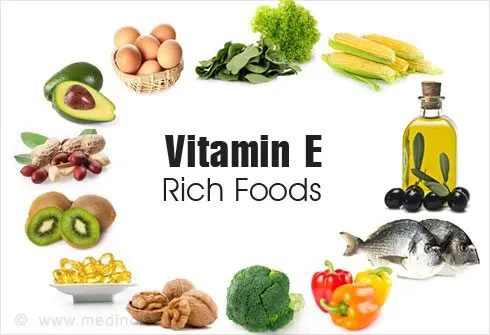Foods containing vitamin E. Video
Vitamin E is one of the most important vitamins with antioxidant properties. The action of the vitamin is usually associated with skin health, but it also plays a role in the proper functioning of many organs of the body. Make sure you get enough vitamin by eating many foods rich in it.
Vitamin E (alpha tocopherol) is an important fat-soluble antioxidant compound that helps the body neutralize the harmful effects of fat oxidation by fighting free radicals, it prevents the development of certain chronic diseases and the aging of body cells. Vitamin E is a vital element in maintaining a healthy immune system.
This vitamin helps to cope with stress, promotes fertility, minimizes the risk of cancer and ischemia, and reduces blood clotting. Vitamin E is useful for women, as it relieves menstrual cramps, fights dysmenorrhea. It is recommended for pregnant and lactating women. Those who do not consume enough vitamin E often complain of inability to concentrate and high fatigue. Low libido can also be the result of a vitamin E deficiency.
Medical experts have proven the benefits of vitamin E in the prevention of mental disorders such as dementia and Alzheimer’s disease
One of the most vitamin E-rich foods is almonds. Just 30 g of raw almonds contain 7,5 mg of this vitamin, and almond milk and almond oil are also rich in vitamin E.
About 30 grams of hazelnuts can provide you with 20% of your required daily intake of vitamin E. The same amount of pine nuts contains 2,6 mg of vitamin E. There is vitamin E in pistachios, but it is important to eat these nuts unroasted, as heat treatment reduces the dose of nutrients. The peanut butter loved by children contains about 2,5 mg of vitamin E in just two tablespoons.
Raw sesame seeds, pumpkin seeds, or sunflower seeds are excellent sources of vitamin E. You can use the seeds as a healthy snack, or you can put them in a salad or sprinkle them on dishes.
Most vegetable oils are a good source of vitamin E. Wheat germ oil contains the most nutrients, just one tablespoon of oil a day will satisfy your daily need for vitamin E by 100%. Sunflower oil, which is often used in cooking, contains about 5 mg of the vitamin. Other vitamin-rich oils are: – hemp oil; – cottonseed oil; – olive oil; – safflower oil.
To get the maximum dose of the vitamin, it is recommended to buy cold-pressed organic unrefined oils.
Fresh juicy tomatoes, rich in vitamins C, A and K, iron, dietary fiber, also contain about 0,7 mg of vitamin E per medium fruit. Tomatoes are widely used in cooking – they are used to make soup, they are put in stews and stir-fries, pasta, pizza, sauces and salads. It is not at all difficult to get the right dose of the vitamin just by eating tomatoes. Vitamin E is also found in vegetables such as potatoes, corn, cabbage and bell peppers. One of the healthiest foods rich in vitamin E is avocado, whose tender, oily flesh contains about 2 mg of vitamin E per 100 g.
Leafy vegetables contain a lot of vitamin E. Spinach is the leader here, satisfying the body’s daily need for vitamin E by 20% with just one cup of blanched greens and Swiss chard – 17% of the daily value in the same dose. Mustard is a little behind, with 14% DV in a cup of raw vegetable. Mustard also contains vitamins K, A, C and folic acid.
Of the fruits, papaya contains the most vitamin E. A 100 g slice can meet 17% of your daily vitamin requirement. Kiwi and mango are essential sources of vitamin E. Just half a cup of mango will give you 0,7 mg of the vitamin, while the same dose of kiwi will give you 1,1 mg. Fruit salad is a great food, and it tastes much better than a simple capsule with just the right dose of the vitamin.
Some herbs, both fresh and dried, contain vitamin E. Common parsley, which can be added to salad or hot dishes, even when dried, contains 0,14 mg of vitamin E per tablespoon. Popular in Italian cuisine, the oregano spice contains about 0,19 mg of vitamin E in just one teaspoon of dried product. Another herb beloved by Italians is basil, in addition to vitamins C, K, B vitamins calcium, iron, phosphorus, it also contains vitamin E.
Risks of Excessive Vitamin E Consumption
Vitamin E is fat-soluble, it is able to accumulate in the body. Vitamin E hypervitaminosis can lead to dizziness, fatigue, headaches, blurred vision, diarrhea, and necrotizing entericolitis.
The recommended daily intake of vitamin E is 15 mg for everyone over the age of 14. The recommended dose for children depends on the age. This is 11 mg for children aged 9 to 13 years, 7 mg for toddlers aged 8 to 4 years, children under 4 and under one year old should not take more than 6 mg of vitamin daily, and no more than 3,5 mg of vitamin E should be contained in the nutrition of infants.











Уеепропанртоитбьипегооооооооорпппиррррррпкккепмне рроипглике және басқа не істеп жатсың мен өзім де бар екен ғой деп ойлаймын мен өзім де бар екен деп тілеймін мен де рахмет әпше өзіңіз қалайсыз апай қалайсыз Рано айто қалайсыз Рано айто туылған күні ма екен деген сөз де бар жақсылықты